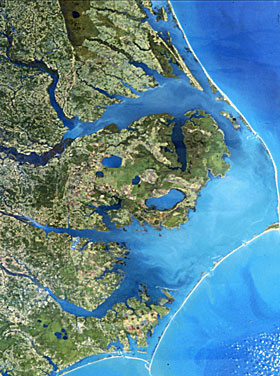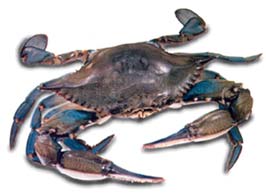



| Blue Crabs | Oysters | Cynthia Cudaback |

In January, 2004, I started working with a group that studies the transport of blue crab larvae and juveniles in Pamlico Sound. The standard model is that blue crab larvae, which spawn at or near the ocean, migrate into the lower salinity waters of the estuary by riding flood tides. Lab studies have suggested that the larval crabs swim to the surface in response to salinity increases on early flood, and descend again in response to changing turbulence on late flood. This model applies quite well to Chesapeake Bay, with a strong along-estuary salinity gradient and strong tides, but it is not clear a-priori that it should apply in Pamlico Sound. In this lagoonal estuary, circulation and salinity changes are more wind-driven than tidal.
Nathalie Reyns combinined extensive field observations with a wind-driven circulation model for her PhD study (Reyns, 2004). She found that to get to the western part of Pamlico Sound, where they are observed in abundance, crab larvae must use flood tide transport near the inlets, and also ride wind-driven currents.
I suggested a complementary study, focusing on a single location but trying to improve the temporal resolution of the observations. Nathalie and I chose a location near Oregon Inlet, a major source of blue crab larvae in Pamlico Sound. I deployed a bottom-mounted ADCP and CTD (to measure currents and salinty continuously), and left it there for three months in 2004. Dave Eggleston and Gayle Plaia went out every night for a week in September, to sample blue crab larvae at four depths, each hour.
From the intensive study, we learned that blue crab larvae in the Pamlico Sound do indeed respond to darkness and to near-bottom salinity by swimming vertically. However, at our particular field site, near bottom salinity increases on the end of flood, so a larva that swims upward in response to salinity gains no advantage in transport. However, currents in our study area are strong enough to account for significant cross-sound transport, even among larvae whose behaviors inhibit transport.
